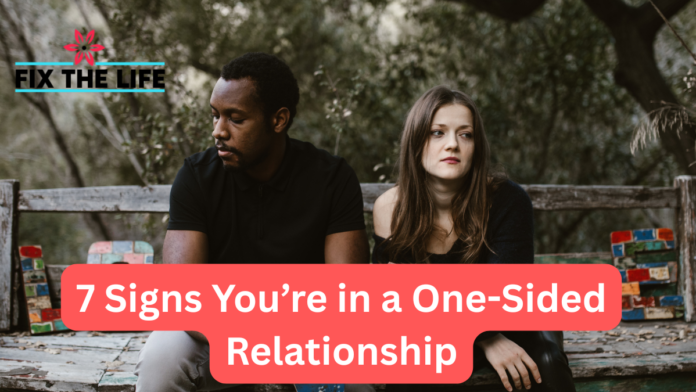Healthy relationships are built on mutual respect, effort, and emotional reciprocity. But what happens when one person gives more than they receive—emotionally, mentally, or physically? If you’ve been feeling drained, ignored, or undervalued, you might be experiencing a one-sided relationship.
In this article, we’ll explore seven warning signs you’re in a one-sided relationship, explain how these patterns create emotional imbalance, and help you spot potential toxic relationship traits before they cause long-term damage.
7 Toxic Relationship Signs
1. You’re Always the One Reaching Out
Whether it’s initiating conversations, making plans, or checking in after an argument, the emotional labor seems to fall entirely on you. If you’re constantly the one texting first, planning dates, or resolving conflicts, it may be a sign your partner isn’t equally invested.
Real-life red flag: You send multiple messages before they reply—or worse, they ignore you until it’s convenient for them.
2. Your Needs and Feelings Are Overlooked
In balanced relationships, both people’s feelings matter. In one-sided dynamics, your emotions may be dismissed, downplayed, or ignored altogether. Your partner may change the subject, minimize your concerns, or turn the focus back on themselves.
Why it matters: Ignoring emotional needs leads to emotional imbalance, where one person’s voice is consistently silenced.
3. You Feel Drained Instead of Supported
Relationships should offer comfort, not constant stress. If you leave interactions feeling emotionally exhausted, anxious, or like you’re walking on eggshells, that’s not love—that’s imbalance.
Ask yourself: Do I feel more at peace alone than when I’m with them? If yes, that’s a key warning sign.
4. They Don’t Prioritize You
A partner who cares will make time for you, even on busy days. If you feel like an afterthought—squeezed in only when it suits their schedule—you’re not being valued equally.
Example: You’re always available when they call, but they cancel or reschedule plans when you need them most.
5. You Make All the Compromises
Compromise is part of every healthy relationship—but it shouldn’t be one-sided. If you’re always the one adjusting your plans, interests, or boundaries to keep the peace, you’re not in a partnership—you’re in a performance.
Watch out for: Sacrificing your values, hobbies, or friendships just to keep the relationship going.
6. You’re Unsure Where You Stand
In a one-sided relationship, the emotional security you crave is often missing. If your partner avoids defining the relationship, withholds affection, or seems hot and cold, it’s a sign of emotional unavailability.
Emotional clarity matters. Ambiguity fuels anxiety and keeps you trapped in an unbalanced dynamic.
7. Your Self-Worth Is Declining
Perhaps the most damaging of all signs is how you feel about yourself. One-sided relationships often erode self-esteem, making you question your worth and believe that you must work harder to “earn” love.
Toxic relationship traits like emotional neglect or passive-aggressive behavior can cause lasting harm to your confidence.
The Emotional Toll of One-Sided Relationships
Being in a relationship where love and effort aren’t mutual doesn’t just hurt—it can change how you view yourself and future relationships. Over time, it may lead to emotional burnout, trust issues, or a distorted view of what love should feel like.
Recognizing these signs you’re in a one-sided relationship is the first step toward healing. You deserve a connection rooted in respect, care, and equality.
What to Do If You Recognize These Signs
- Reflect Honestly: Ask yourself if your needs are being met and whether your partner is willing to change.
- Communicate Openly: Share your concerns calmly but clearly. A healthy partner will listen and respond.
- Set Boundaries: Learn to protect your energy and make decisions that support your well-being.
- Seek Support: Whether through friends, family, or a therapist, don’t navigate this alone.
FAQ
Q1: Can a one-sided relationship become healthy?
A: Yes, but only if both people are willing to acknowledge the imbalance and actively work to rebuild mutual trust and effort.
Q2: Is it normal for one person to give more in a relationship sometimes?
A: Temporary imbalances are normal, especially during stressful periods. Persistent imbalance, however, is a sign of a deeper issue.
Q3: What are the long-term effects of staying in a one-sided relationship?
A: Emotional exhaustion, lowered self-esteem, difficulty trusting others, and a skewed perception of love are common long-term effects.
Q4: How do I bring this up with my partner without sounding accusatory?
A: Use “I” statements (e.g., “I feel unsupported when…”) instead of blaming language. Focus on how the dynamic impacts you emotionally.
Q5: When is it time to walk away?
A: If your partner consistently dismisses your concerns, refuses to communicate, or shows no intention of changing, it may be time to prioritize your mental health and move on.
Final Thoughts
Understanding the signs you’re in a one-sided relationship empowers you to make informed, healthy choices. Relationships should uplift you, not leave you questioning your value. If you’re doing all the giving with little in return, it’s not selfish to ask for more—it’s essential for your emotional well-being. Love should never feel like a burden carried alone. You deserve balance, respect, and real partnership.




